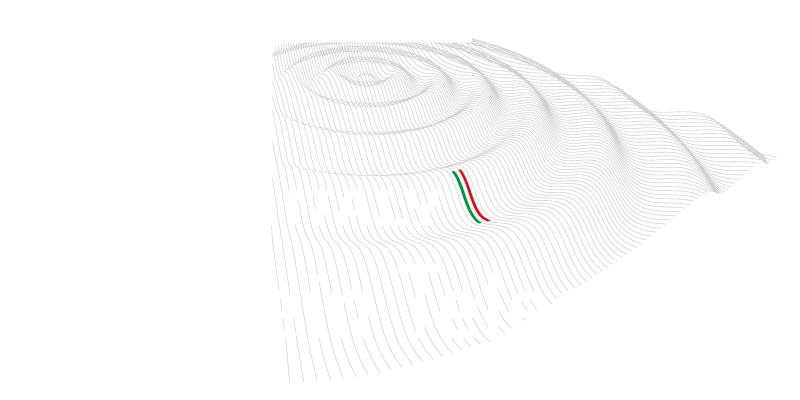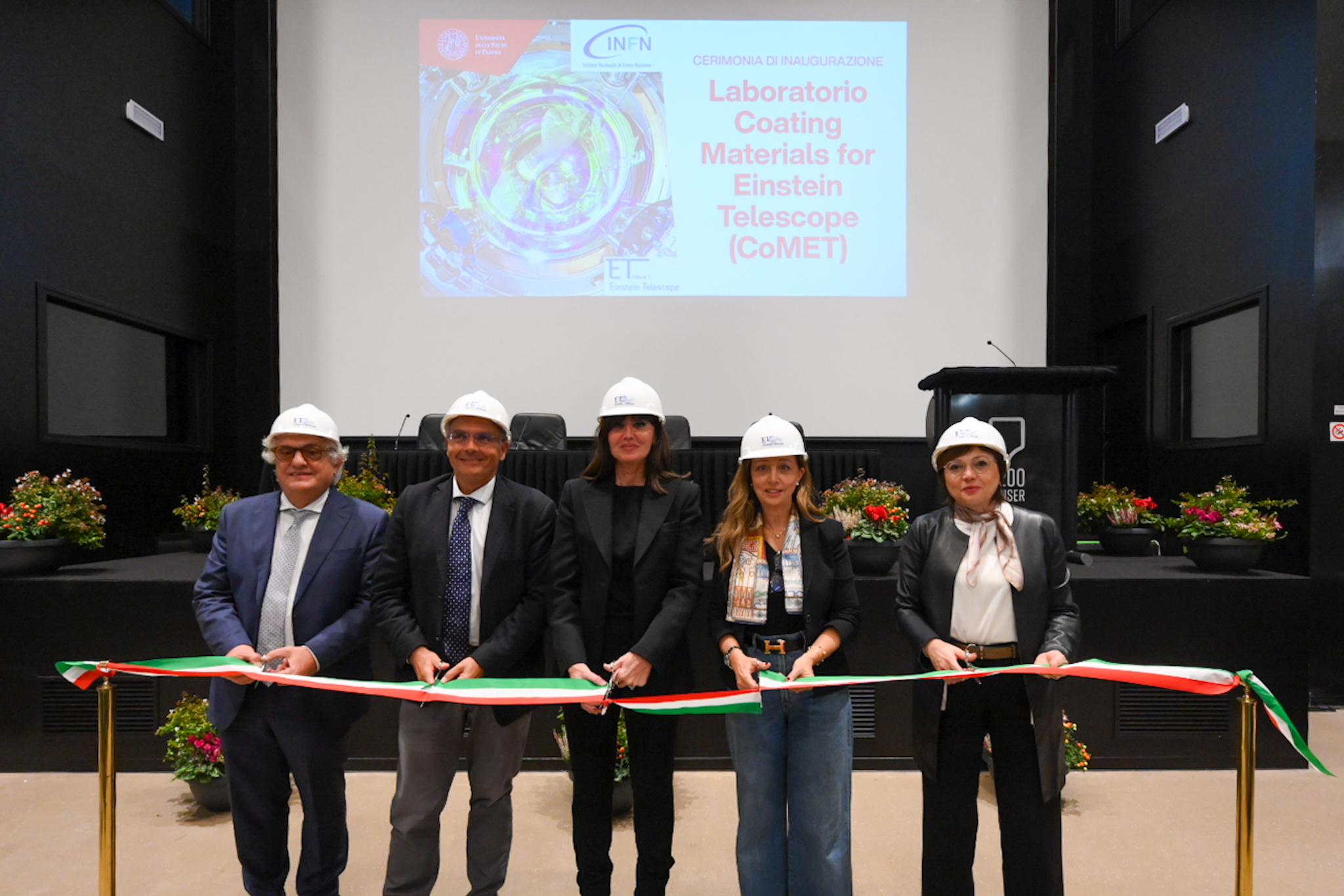Today, Monday, October 6, at the CenSer in Rovigo, the CoMET laboratory – acronym for Coating Materials for Einstein Telescope – was inaugurated. The facility is funded by the European Union (Next Generation EU) – NRRP within the framework of the national ETIC project, dedicated to creating a network of infrastructures to support the Einstein Telescope (ET).
ET is a major European research project of global relevance, dedicated to the detection of gravitational waves. Italy is a candidate to host it in Sardinia, in the area of the disused Sos Enattos mine. Thanks to the ETIC project, which also aims at the site’s characterization, Sos Enattos is emerging as a unique location worldwide for its seismic quietness and low human impact.
At the CoMET laboratory, the coatings for the mirrors to be used in this futuristic scientific infrastructure will be developed. The mirrors of ET will function thanks to thin layers of special materials deposited on their reflective surfaces: the quality of these coatings is crucial to increase the detector’s sensitivity. The new multidisciplinary space, equipped with advanced instrumentation, will make it possible to fabricate and test reflective layers under different conditions.
The new telescope and the technological advances behind it will enhance the ability to detect even the faintest gravitational waves. Indeed, the Einstein Telescope will be able to observe a volume of the universe at least a thousand times greater than current instruments. This will allow unprecedented precision in studying the origins and evolution of the cosmos, opening new paths for fundamental physics, astrophysics, and cosmology. Scientists, engineers, and technicians are currently focusing on the preparatory phase (ET Preparatory Phase Project, funded by Horizon Europe), which includes studying the detector configuration, designing and developing enabling technologies, preparing data analysis methodologies, and building astrophysical models to interpret the measurements and collected data.
Einstein Telescope – for which the Italian government has already earmarked nearly one billion euros – represents not only a frontier in gravitational wave exploration, but also an outstanding example of big science where vision of the future merges with technological innovation. The creation of CoMET in Rovigo fits into this context, contributing to the development of key technologies and strengthening international scientific collaboration. The laboratory demonstrates how the Italian candidacy in Sardinia is already producing tangible outcomes for the national scientific community, enriching infrastructure and expertise network.
In this framework, the contribution of the Padua scientific community – part of an international collaboration involving over 1,800 experts from 31 nations – confirms the importance of Padua’s academic work in the global research scene. The University of Padua and its local branches of the National Institute for Nuclear Physics (INFN) and the National Institute for Astrophysics (INAF) are strongly engaged in many theoretical and experimental aspects of the project.
The construction of CoMET is funded by the European Union (Next Generation EU) – NRRP, within the strengthening and creation of research infrastructures. The resources allocated to the Department of Physics and Astronomy “Galileo Galilei” of the University of Padua amount to about 2 million euros, plus more than 800,000 euros managed by the Padua section of INFN. The establishment of the laboratory, located in University spaces at CenSer in Rovigo, is also significantly supported by the Cassa di Risparmio di Padova e Rovigo Foundation (1.4 million euros).
«Science teaches us that every discovery opens new paths, and CoMET is one of them. Today we inaugurate an infrastructure – declares Anna Maria Bernini, Minister of University and Research – born from the excellence and vision of our universities and scientific community, and which represents a decisive step in the race to clinch the Einstein Telescope. CoMET shows that Veneto knows how to speak of the future, of innovation, of great discoveries. It also confirms how Italian university research, with its excellence, can transform knowledge into progress, creating value for the territory and opportunities for the country. With initiatives like this, we demonstrate that our universities and research institutions are not just places of knowledge, but engines capable of attracting talent, building international collaborations, and driving Italy’s technological and economic growth. Thanks to this strength and the ability to build networks, we can face with confidence the most ambitious challenges of science and transform them into opportunities for the country’s future».
«The CoMET laboratory is a fundamental element of the ETIC project, promoted by the Ministry of University and Research under NRRP and coordinated by INFN: a collective effort that supports the Italian candidacy to host the Einstein Telescope in Sardinia, the world’s most advanced gravitational wave detector. This project places Italy — and Padua — at the center of the great European endeavor to understand the universe. With the Einstein Telescope, our gaze will reach the boundaries of space and time, where the most extreme phenomena originate: the collision of black holes, the birth of neutron stars, the events that shape the cosmos», says Daniela Mapelli, Rector of the University of Padua. «It will be the ideal continuation of a path begun more than a century ago, when Albert Einstein, with his theory of general relativity, taught us that space and time are not static entities, but elastic fabrics rippling under the passage of energy and matter. Here, the optical coatings of the mirrors will be developed to enable the telescope to detect gravitational waves with unprecedented sensitivity. These are cutting-edge technologies, based on materials and deposition techniques that must meet extreme requirements of precision, stability, and resistance. Every progress achieved in these laboratories will directly translate into a greater ability to listen to the universe. But CoMET is not just a physics lab: it is a laboratory of the future. It shows how research can be born from a shared vision and grow through collaboration among different disciplines and institutions».
«The CoMET laboratory, which comes to life today thanks to the valuable support of the Ministry of University and Research and the fruitful collaboration between the University of Padua, INFN, and INAF, will work on essential aspects to reach the required sensitivity of the Einstein Telescope – explains Marco Pallavicini, member of the INFN executive board. Producing and testing innovative materials to optimize ET’s performance requires cutting-edge equipment and considerable R&D effort. As INFN we are proud to contribute to this crucial aspect for the realization of the mirrors for ET and for other gravitational interferometers».
«It is a source of great pride for our department to see our researchers involved in a scientific project of such international scope as the Einstein Telescope. Our ability to attract significant funding, such as the 3 million euros from NRRP, is the result of a consolidated scientific tradition recognized internationally», states Flavio Seno, Director of the Department of Physics and Astronomy “Galileo Galilei” of the University of Padua. «This allows us to keep our department at the forefront of cutting-edge research thanks to excellence in science, the ability to develop advanced technologies and methodologies, and a wide network of international collaborations. These features demonstrate not only scientific excellence, but also the ability to contribute significantly to the innovation and development goals of NRRP».
«The Padua scientific community has a long tradition internationally recognized in gravitational wave research. In the 1980s and 1990s, the INFN Padua section, in collaboration with the National Laboratories of Legnaro, led the construction of the AURIGA experiment, one of the very few experiments worldwide designed for the direct detection of gravitational waves. In later years – recalls Roberto Carlin, director of the INFN Padua section – when interferometer technology took over, Padua unit played a key role in the development of the VIRGO detector in Pisa, which successfully observed these elusive phenomena in 2017. We are proud to continue contributing actively to this frontier research with the new CoMET laboratory».
«The inauguration of the CoMET laboratory in Rovigo marks a crucial moment for Italian and international scientific research – stress Marco Bazzan, scientific coordinator for the University and INFN Padua section, and Giacomo Ciani, project collaborator and former scientific coordinator for the University of Padua. This cutting-edge laboratory is a new and important technological infrastructure serving the international scientific community and represents a bridge to the future of gravitational astronomy. The collaboration between the University of Padua, INFN, and other key project partners demonstrates how frontier science requires joint efforts and shared vision. CoMET is not only an interdisciplinary research tool but a step forward for Italy and Europe in gravitational wave research».
«Supporting the CoMET laboratory means investing in a vision of the future that combines scientific excellence, technological innovation, and local development. The Foundation chose to contribute significantly to this globally important venture because it believes in the strategic value of collaboration between institutions, universities, and research centers – concludes Gilberto Muraro, President of the Cassa di Risparmio di Padova e Rovigo Foundation. Locating the laboratory within the CenSer complex also fits perfectly with our strategy to transform it into a modern hub of innovation, education, and culture, capable of attracting talent, generating opportunities, and strengthening Polesine’s role in research and development».
The ceremony was attended by Anna Maria Bernini, Minister of University and Research, Daniela Mapelli, Rector of the University of Padua, Marco Pallavicini, member of the INFN executive board, and Gilberto Muraro, President of the Cassa di Risparmio di Padova e Rovigo Foundation. Contributions were made by Marco Pallavicini, member of the INFN executive committee who presented Ithe Italian candidacy to host the Einstein Telescope in Sardinia; Michele Punturo, coordinator of the international Einstein Telescope collaboration, who illustrated the project of the future gravitational detector; and Marco Bazzan, head of the CoMET laboratory, who explained the features and objectives of the new international laboratory.

